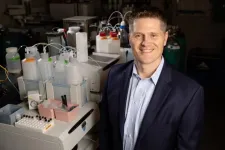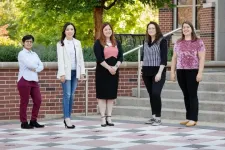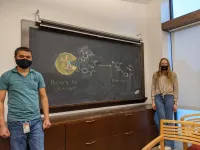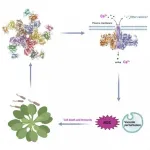(Press-News.org) NEW YORK, NY--While there was extensive use of drug repurposing throughout the first 10 months of the COVID-19 pandemic, there was substantial heterogeneity over the types of drugs used for treatment purposes globally. Some drugs, including hydroxychloroquine, saw sharp declines in use, while adjunctive therapies grew into a more relied upon method for patient management.
In a number of cases, scientific discovery overturned misconceptions proclaimed via press conferences and social media.
The OHDSI network study "Use of repurposed and adjuvant drugs in hospital patients with covid-19: multinational network cohort study," published May 11 by The BMJ, provides a global view of drug utilization in routine practice of more than 303,000 hospitalized patients from China, South Korea, Spain and the United States. The study highlights the need for future research on the safety and efficacy of the more commonly used treatments.
"At the start of the pandemic, when we knew little about COVID-19 and how to treat it, there were many differences between hospitals around the world on how health professionals were treating it," said study co-lead Albert Prats-Uribe, a DPhil candidate and Research Assistant in Clinical Epidemiology at the University of Oxford.
"This was also influenced by political and social media pressures that spread misinformation," said senior author Dani Prieto-Alhambra, Professor of Pharmaco- and Device Epidemiology at the University of Oxford. "Once reliable evidence from well-designed and performed studies came in, the situation quickly improved, and hospitals stopped using the ineffective treatments and turned to more effective ones."
Deidentified patient data from 11 databases across three continents (Asia, Europe and North America) showed that more than 3,400 different medicines were used in the treatment of COVID-19 patients. Among the most popular in the earliest stages of the pandemic was hydroxychloroquine, which was heavily promoted without the backing of reliable evidence and later revoked from emergency approval status following both randomized controlled trials (RCTs) and related studies, including an OHDSI study showing dangerous risk of combining hydroxychloroquine with another early popular prescribed COVID-19 therapeutic, azithromycin.
Heterogeneity in drug therapy choice was dramatic across databases around the world. For example, lopinavir-ritonavir was used 50% of the time in one Spanish setting (HM Hospitals), 35% of the time in a South Korean setting (HIRA), and 0% of the time in a U.S. setting (Department of Veterans Affairs).
Adjunctive therapies developed into popular forms of management for supportive care, with the most recognized being corticosteroids and anti-cytokines, both of which have been shown to reduce mortality in more serious cases. While these were lightly used early in the pandemic, results from the RECOVERY RCT showed efficacy in reducing death on hospitalized patients with severe respiratory disease.
Scientific discovery through observational data often reversed false information being distributed through political channels and/or social media. This study highlights the role observational studies can fit into informing clinical decision-making moving forward.
"The use of ineffective medicines and potentially harmful combinations started with information from promising in vitro analyses, and were fueled by poorly performed observational studies, as well as misinformation campaigns in social and traditional media with clearly political intentions," Prats-Uribe said. "This would have taken a long time to counter in the traditional scientific timings. With the work of a community of people around the world producing reliable evidence using observational data, we were able to shift these tendencies and influence decision-making to improve COVID-19 patients."
The study was developed and executed by the OHDSI (Observational Health Data Sciences and Informatics) community, a multi-stakeholder, interdisciplinary network that collaborates globally to bring out the value of health data through open science and large-scale analytics.
INFORMATION:
Columbia University serves as the Central Coordinating Center for the OHDSI community.
"OHDSI's common data model provided the foundation for our community to collaborate together on common definitions for COVID-19 patients and to characterize their experience across a large number of countries and healthcare systems," said study co-lead Anthony Sena, Associate Director of Observational Health Data Analytics at Janssen Research & Development, LLC. "Open-source tools such as ATLAS and the HADES libraries enabled us to work together using proven methods to gather results across Asia, Europe and the USA. It was a remarkable experience to work with so many talented people who brought data and seemingly endless amounts of energy to synthesize the vast result set assembled as part of project CHARYBDIS."
More Information
The study, titled "Use of repurposed and adjuvant drugs in hospital patients with covid-19: multinational network cohort study, was published in The BJM on May 11, 2021.
Authors from Columbia are George Hripcsak, Chair and Vivian Beaumont Allen Professor of Biomedical Informatics, and Patrick Ryan, Adjunct Assistant Professor of Biomedical Informatics. Additional authors are included in the paper.
Patrick Ryan is an employee of Janssen Research and Development and shareholder of Johnson & Johnson.
This research received partial support from the National Institute for Health Research (NIHR) Oxford Biomedical Research Centre, US National Institutes of Health (R01 LM00691), US Department of Veterans Affairs, Janssen Research and Development, and IQVIA. This work was also supported by the Bio Industrial Strategic Technology Development programme (20001234) funded by the Ministry of Trade, Industry, and Energy (MOTIE, Korea) and a grant from the Korea Health Technology R&D Project through the Korea Health Industry Development Institute (KHIDI), funded by the Ministry of Health and Welfare, Republic of Korea (grant No HI16C0992). This study was supported by the National Key Research and Development programme of China (project No 2018YFC0116901). Funding for other co-authors is included in the paper.
URBANA, Ill. - Gut health is having a moment, with sales of fermented foods such as kefir, kombucha, and kimchi steadily on the rise. The benefits of "good bacteria" in fermented foods and supplements go well beyond the gut, moderating immune responses, heart health, weight, and even mood. But do products hold up to the claims on their labels?
A new study from the University of Illinois and The Ohio State University examined bacterial content of five brands of kefir, a fermented dairy beverage often likened to drinkable yogurt. The research showed the majority of products overstated bacterial density and contained species not included on the label.
"Our ...
The ability to connect and feel a sense of belonging are basic human needs but new Swansea University research has examined how these are determined by more than just our personal relationships.
Research led by psychologist Professor Andrew Kemp, of the College of Human and Health Sciences, highlights the importance of taking a wider approach to wellbeing and how it can be influenced by issues such as inequality and anthropogenic climate change.
Professor Kemp worked with PhD student Jess Mead and consultant clinical psychologist Dr Zoe Fisher, of the University's Health and Wellbeing Academy, on the study which presents a transdisciplinary ...
CHAMPAIGN, Ill. -- Young people with diverse gender identities may be bullied and victimized up to three times more often than peers who identify as male or female, a new study of more than 4,464 adolescents in Illinois found.
The students were part of a statewide survey of eighth- through 12th-grade youths in Illinois schools.
"Transgender youths reported the highest rates of all forms of peer victimization, which were double to nearly triple those of males and up to 2.6 times higher than those of females," said social work professor Rachel Garthe of the University of Illinois Urbana-Champaign, who led the research.
"Slightly ...
Can a protein found in a mosquito lead to a better understanding of the workings of our own brains? Prof. Ofer Yizhar and his team in the Weizmann Institute of Science's Neurobiology Department took a light-sensitive protein derived from mosquitos and used it to devise an improved method for investigating the messages that are passed from neuron to neuron in the brains of mice. This method, reported today in Neuron, could potentially help scientists solve age-old cerebral mysteries that could pave the way for new and improved therapies to treat neurological and psychiatric conditions.
Yizhar and his lab team develop so-called optogenetic methods - research techniques that allow them to "reverse engineer" the activity of specific brain circuits ...
EAST LANSING, Mich. - As climate change threatens global food security, researchers at Michigan State University are building better beans crucial to human nutrition by tapping into the genetics of the more heat-resistant tepary bean.
The tepary bean (Phaseolus acutifolius A. Gray) is a sister of the common bean which includes kidney, pinto and navy beans. "The common bean is the number one source of protein and nutrients for many people living in Central America and Africa," said Robin Buell, a professor of plant biology in MSU's College of Natural Science and former director of the Plant Resilience Institute.
Her research on bean genetics was published May 11 in Nature Communications.
"Mother nature has already made plants that are adapted to different climates," ...
Molecules are the building blocks for our modern world, from phones to cars to Doritos. But coming up with new ones is still an incredibly costly and time-consuming process. A group of University of Chicago chemists wants to find a better way.
"If you look at a diagram of a molecule, it seems like you should be able to just snap them together like Tinkertoys, but you can't," said Asst. Prof. Mark Levin. "We'd like to change that."
Their new discovery, published May 12 in Nature, represents a first step towards that transformation: a way to easily cut nitrogen atoms from molecules.
Despite decades of experiments, chemistry remains an art in many ways because molecules are built in a long, iterative process: attaching ...
In plants, disease resistance proteins serve as major immune receptors that sense pathogens and pests and trigger robust defense responses. Scientists previously found that one such disease resistance protein, ZAR1, is transformed into a highly ordered protein complex called a resistosome upon detection of invading pathogens, providing the first clue as to how plant disease resistance proteins work. Precisely how a resistosome activates plant defenses, however, has been unclear.
A joint team led by Profs. ZHOU Jianmin, CHEN Yuhang and HE Kangmin at the Institute of Genetics and Developmental Biology of the Chinese Academy of Sciences and Prof. CHAI Jijie at Tsinghua University recently employed state-of-the-art electrophysiology and single-molecule imaging to investigate the molecular ...
Scientists are exploring a number of ways for people with disabilities to communicate with their thoughts. The newest and fastest turns back to a vintage means for expressing oneself: handwriting.
For the first time, researchers have deciphered the brain activity associated with trying to write letters by hand. Working with a participant with paralysis who has sensors implanted in his brain, the team used an algorithm to identify letters as he attempted to write them. Then, the system displayed the text on a screen - in real time.
The innovation could, with further development, let people with paralysis rapidly ...
PROVIDENCE, R.I. [Brown University] -- Researchers with the BrainGate collaboration have, for the first time, used an implanted sensor to record the brain signals associated with handwriting, and used those signals to create text on a computer in real time.
In a study published in the journal Nature, a clinical trial participant with cervical spinal cord injury used the system to "type" words on a computer at a rate of 90 characters per minute, more than double the previous record for typing with a brain-computer interface. This was done by the participant merely thinking about the hand motions involved in creating written letters.
The research team is hopeful that such a system could one day help to restore ...
Scientists have for the first time revealed the structure surrounding important receptors in the brain's hippocampus, the seat of memory and learning.
The study, carried out at Oregon Health & Science University, published today in the journal Nature.
The new study focuses on the organization and function of glutamate receptors, a type of neurotransmitter receptor involved in sensing signals between nerve cells in the hippocampus region of the brain. The study reveals the molecular structure of three major complexes of glutamate receptors in the hippocampus.
The findings may be immediately useful in drug development for conditions such as epilepsy, said senior author Eric Gouaux, Ph.D., senior scientist in the OHSU Vollum Institute, ...





